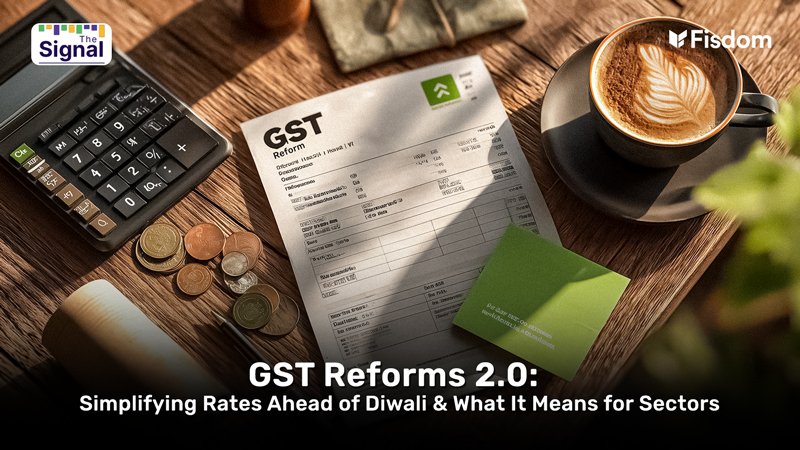
The first quarter of FY26 is shaping up to be a mixed but crucial period for India Inc., with investors focused more on forward guidance than headline growth numbers. While macroeconomic headwinds such as geopolitical uncertainty, fluctuating crude oil prices, and interest rate adjustments globally continue to create noise, domestic tailwinds in the form of government-led capital expenditure, stable liquidity, and policy support from the Reserve Bank of India are offering much-needed support.
Despite ongoing supply chain issues and the disruptive impact of unseasonal rainfall in some parts of the country, early signs from high-frequency indicators suggest some degree of sequential improvement. However, broad-based consumption recovery, particularly in urban segments, remains elusive. Most analysts agree that while the worst of earnings downgrades may be behind us, the market still appears to be one or two quarters away from witnessing meaningful upgrades. Hence, the management commentaries this earnings season are expected to play a pivotal role in setting the tone for the rest of the year.
One of the standout sectors this quarter is telecom, which continues to benefit from improved subscriber monetization and stronger operational efficiency. The sector is expected to showcase robust profitability, reflecting improved pricing power and cost discipline. Meanwhile, financials—especially non-banking financial companies (NBFCs)—could see relatively better performance compared to banks. NBFCs catering to vehicle and diversified financing are anticipated to maintain strong asset under management (AUM) growth, although disbursements may witness some seasonal slowdown. For banks, investor attention will be closely focused on commentary around credit growth, asset quality in the unsecured segment, and the future direction of net interest margins.
The cement and construction materials sectors are also poised to benefit from the continued momentum in government infrastructure spending. After a muted first half last fiscal year, cement demand saw an uptick in the later quarters, and this momentum appears to be carrying into Q1 FY26. Improved pricing, coupled with a rebound in construction activity, has boosted sentiment in this space.
On the other hand, consumer-facing sectors, particularly fast-moving consumer goods (FMCG) and retail, continue to face headwinds. Urban consumption demand remains soft, with rural markets slightly outperforming. Input costs and muted volume growth continue to restrict earnings expansion in these sectors. The guidance from FMCG companies, especially regarding margin outlook and demand recovery, will be key monitorables.
The automobile sector is likely to face a challenging quarter as well. With commodity prices creeping up again and regulatory cost pressures adding to the mix, OEMs could see a contraction in profitability. While overall demand remains uneven, segments like tractors could provide some relief due to favourable monsoon trends and improved rural liquidity. However, the broader auto space is expected to reflect moderate to weak performance, and investor expectations remain conservative.
Healthcare and pharmaceuticals present a slightly more optimistic picture. Domestic formulation sales and new launches in the U.S. market are contributing to stable top-line growth. However, a cloud of uncertainty persists around the potential impact of trade-related developments, especially any new tariff measures targeting Indian pharma exports. The hospital segment, in contrast, continues to benefit from a gradual rise in occupancy levels and the addition of new capacity, pointing to an improving outlook in the broader healthcare delivery space.
In the industrials segment, expectations are mixed. While the broader capital goods and infra-related companies are likely to benefit from project execution and government capex, seasonality and execution bottlenecks could weigh on margins. Commentary around order books and execution timelines will be important to track.
The information technology sector is expected to report a stable but unspectacular quarter. The global macro slowdown and cautious enterprise spending patterns are likely to keep revenue growth muted. That said, currency tailwinds and cost efficiencies could support margins to some extent. Investors will closely monitor management guidance on deal pipelines, discretionary spending recovery, and margin resilience.
Overall, the Q1 FY26 earnings season appears to be one of relative stability rather than strong acceleration. Many sectors are in a wait-and-watch mode, and the broader earnings landscape continues to reflect India’s patchy economic recovery. Yet, certain pockets—such as telecom, cement, NBFCs, and healthcare—offer rays of optimism. With market valuations already pricing in some amount of resilience, positive surprises on the earnings or guidance front could set the stage for a broader market move later in the fiscal year.
Ultimately, this earnings season is less about short-term numbers and more about validating the recovery narrative. If management outlooks remain constructive and macro risks such as trade volatility and inflation remain contained, Q1 FY26 could lay the foundation for a more robust second half, both for corporate India and the markets
Market this week
| 07th July 2025 (Open) | 11th July 2025 (Close) | %Change | |
| Nifty 50 | ₹ 25,450 | ₹ 25,150 | -1.2% |
| Sensex | ₹ 83,398 | ₹ 82,500 | -1.1% |
Source: BSE and NSE
- The Indian equity markets ended the week in the red, with benchmark indices losing between 0.6% to 1%.
- Volatility persisted due to a weak start to the Q1 FY26 earnings season, dampening investor sentiment.
- Uncertainty around ongoing trade negotiations with the US further weighed on market mood.
- Global concerns escalated after President Donald Trump signaled potential blanket tariffs of 15–20% on major trade partners.
- Foreign Institutional Investors (FIIs) extended their selling for the second consecutive week, pulling out ₹4,511.12 crore from equities.
- Domestic Institutional Investors (DIIs) continued to support the market, registering their 12th straight week of net buying, with ₹8,291 crore invested in equities.
Weekly Leaderboard
| NSE Top Gainers | NSE Top Losers | ||||
| Stock | Change (%) | Stock | Change (%) | ||
| HUL | ▲ | 7.7% | Titan Ltd | ▼ | -8.8% |
| Kotak Mahindra Bank | ▲ | 4.3% | HCL Tech | ▼ | -5.1% |
| NTPC | ▲ | 2.2% | Apollo Hospitals | ▼ | -4.8% |
| SBI Life Insurance | ▲ | 2.0% | Bharti Airtel | ▼ | -4.7% |
| Power Grid Corp | ▲ | 1.6% | TATA Consultancy | ▼ | -4.5% |
Source: BSE
Stocks that made the news this week:
Glenmark Pharma surged 15 percent to a fresh 52-week high on July 11 following a major licensing agreement with US-based AbbVie. The deal, signed by Glenmark’s step-down subsidiary Ichnos Glenmark Innovation (IGI), grants AbbVie exclusive global rights (excluding Emerging Markets) to develop and commercialise ISB 2001—an investigational asset currently in Phase 1 trials for multiple myeloma. Glenmark will retain commercialisation rights across Emerging Markets, including Asia, Latin America, and parts of Europe and Africa, marking a significant milestone in its innovation-led growth strategy.
Anand Rathi Wealth shares jumped over 5 percent after the company reported strong Q1 FY26 earnings, with net profit rising nearly 28 percent year-on-year to ₹93.9 crore. The firm’s operating revenue grew 15.3 percent, driven by robust gains in mutual fund distribution and other financial products. EBITDA margins improved significantly to 46.6 percent, aided by higher revenue and cost efficiencies. The company’s assets under management (AUM) also saw healthy growth, with a 27 percent YoY increase to ₹87,800 crore, underscoring sustained traction in its wealth management business.
IREDA shares fell 6 percent on July 11 as deteriorating asset quality overshadowed its loan growth in the June quarter. The state-run renewable energy financier reported a sharp 35.7 percent YoY decline in net profit, impacted by a spike in gross NPAs to 4.13 percent, up from 2.45 percent in the previous quarter. Investor concerns mounted over its ₹470 crore exposure to Gensol Engineering, which has entered insolvency proceedings. Despite initiating legal action through the NCLT, the setback has renewed scrutiny over IREDA’s risk management and credit assessment practices.














